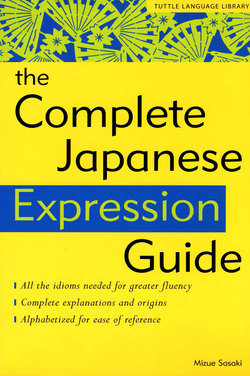Читать книгу Complete Japanese Expression Guide - Mizue Sasaki - Страница 6
На сайте Литреса книга снята с продажи.
ОглавлениеINTRODUCTION
In the past decade, there has been a sharp increase in the number of foreigners studying Japanese, and consequently, good textbooks covering all levels of the language have begun to appear. However, these textbooks tend to avoid the use of idiomatic expressions, which is unfortunate because these expressions are used very frequently in daily language.
Studying Japanese without coming to terms with the use of idiomatic expressions is like preparing a dish but forgetting to add salt. Idiomatic expressions are used all the time in Japanese, perhaps more often than in English. They appear in newspaper and magazine headlines and of course play an important role in literature.
When I was requested by the Asahi Evening News to write a weekly column on learning the Japanese language, I knew immediately that I wanted to direct my attention to idioms. This column has proven very successful, and has now run for many years.
When I had written about three hundred articles for my column, the Charles E. Tuttle Company approached me with an offer to write a book on idiomatic expressions. So, I went about preparing a text that would both teach idiomatic expressions to foreigners as well as allow Japanese people to learn how idiomatic phrases in Japanese are rendered in English.
In this book, I have chosen three hundred commonly used expressions and devoted one page to each. Each expression is introduced in a situational dialogue so that the reader can understand the context in which the expression is used. Then a brief explanation of the expression's meaning, derivation, and related forms is given, followed by additional example sentences that give various usages of the expression.
I tried in this book to provide examples of the expressions using natural, everyday conversation. A difficult aspect of Japanese is the different styles of language used by different classes of people, such as superiors and subordinates or men and women. Furthermore, different situations demand different language. For instance, the formal atmosphere of a wedding reception requires different expressions and wording than the casual talk between friends at an informal get-together. I have introduced a number of situations in the text—for example, conversations between department chiefs and subordinates, husbands and wives, and friends—in the hope that readers will be able to appreciate the different styles of languages used in various situations.
Learning idiomatic expressions does not involve just the language but also the culture. It comes as no surprise that derivations of idioms draw from diverse areas, such as Buddhist sayings, plays, sumo, gambling, and the samurai tradition. Those who know about the origins of the expressions might therefore appreciate Japanese culture that much more.
I wish to thank the following people for their help with the publication of this book: the staff of the Asahi Evening News and the readers of my column, who drew my attention to the importance of idiomatic expressions in Japanese conversation; the people who helped me with the translation of this text: John Millen, Paul Gilson, Patrick Codd, Timothy Phelan, and James Spahn, whose kind cooperation and encouragement contributed to the compilation of this work; and to the staff of the Charles E. Tuttle Company.
